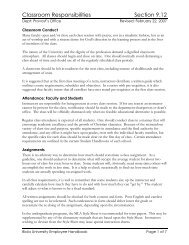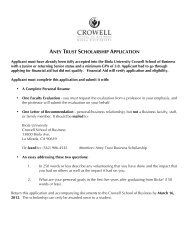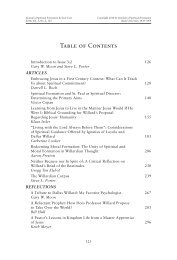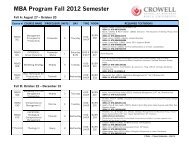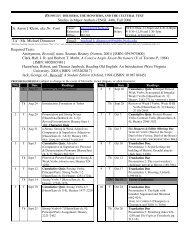Wage and Salary Administration Section 4.1 - Biola - Biola University
Wage and Salary Administration Section 4.1 - Biola - Biola University
Wage and Salary Administration Section 4.1 - Biola - Biola University
You also want an ePaper? Increase the reach of your titles
YUMPU automatically turns print PDFs into web optimized ePapers that Google loves.
<strong>Wage</strong> <strong>and</strong> <strong>Salary</strong> <strong>Administration</strong> <strong>Section</strong> <strong>4.1</strong><br />
Dept: Human Resources Revised: March 1, 2007<br />
<strong>Wage</strong> Structure<br />
The <strong>Biola</strong> method of job evaluation is the job classification method. Each staff position is assigned<br />
to 1 of 11 general position classifications like "J" for janitorial jobs, "S" for secretarial jobs, "E" for<br />
executive positions, <strong>and</strong> so on.<br />
AE Administrative, Exempt PE Professional, Exempt<br />
AN Administrative, Nonexempt PN Professional, Nonexempt<br />
C Clerical R Retail<br />
E Executive S Secretarial<br />
J Custodial T Technical<br />
M<br />
Managerial<br />
Within each classification are levels. The levels designate increasing degrees of skill <strong>and</strong><br />
responsibility. For example, "J2" denotes a higher level position than does "J1." These levels are<br />
defined within each classification. Each position, based on its job description <strong>and</strong> other pertinent<br />
information, is assigned a level within its appropriate classification. There are 3 to 6 levels in each of<br />
the 11 classifications.<br />
Each classification level is then assigned a pay grade based on salary surveys, local job market forces,<br />
<strong>Biola</strong>'s estimation of the position's impact on the institution, <strong>and</strong> <strong>Biola</strong>'s ability to pay for the job.<br />
The exempt (salaried) grade table expresses the monthly pay ranges (minimum, midpoint, maximum)<br />
for positions through grade 22 <strong>and</strong> the nonexempt table, which expresses these same pay ranges in<br />
hourly form for non-exempt positions, through grade 15. On the far right side of each table are the<br />
classification levels assigned to each pay grade.<br />
Minimum, midpoint, <strong>and</strong> maximum are defined as follows:<br />
• Minimum: The rate of pay for an employee who meets the minimum qualifications for the<br />
job.<br />
• Midpoint: The rate of pay for an employee performing 100% efficiency under normal<br />
supervision (<strong>and</strong> the middle point between the minimum <strong>and</strong> maximum rates). The<br />
"average" worker will usually top out at the midpoint unless additional job responsibilities<br />
are assumed or the performance level becomes "above average."<br />
• Maximum: The highest rate of pay for a job grade. Normally this would be paid only to an<br />
employee who performs duties well in excess of those called for in the job description <strong>and</strong><br />
performs them at the greatest possible efficiency for many years. In other words, the space<br />
between midpoint <strong>and</strong> maximum allows room to recognize employees who perform beyond<br />
the call of duty.<br />
A general wage <strong>and</strong> salary administration rule is that the spread (the distance between the minimum<br />
<strong>and</strong> maximum rate) is expressed as a percentage of the midpoint, <strong>and</strong> this percentage increases from<br />
<strong>Biola</strong> <strong>University</strong> Employee H<strong>and</strong>book Page 1 of 3
<strong>Wage</strong> <strong>and</strong> <strong>Salary</strong> <strong>Administration</strong> <strong>Section</strong> <strong>4.1</strong><br />
Dept: Human Resources Revised: March 1, 2007<br />
lowest to highest grade. Also, the distance between midpoints (from one grade to the next) often<br />
increases as the grades increase. The increasingly wider spread within grades <strong>and</strong> the increasingly<br />
greater distance between midpoints is necessary because promotions or transfers to new jobs occur<br />
less frequently for employees in higher grades. In other words, these employees will need, on<br />
average, to spend more time in their grade <strong>and</strong>, therefore, need to have more room to grow. Also,<br />
when promotions do come, pay increases will need to be more substantial. This can compensate for<br />
the long wait <strong>and</strong> reflects the more substantial increases in responsibility that occur with promotions<br />
at this level of responsibility. Another way to look at the wider spread is to consider the fact that<br />
there is a greater difference between marginal <strong>and</strong> excellent performance at the higher graded jobs<br />
than at the lower graded jobs. The difference in degree of impact on the department made by a file<br />
clerk performing at a "marginal" level as compared to a file clerk performing at an "excellent" level is<br />
less than the difference in department impact caused by a marginal manager <strong>and</strong> an excellent<br />
manager. As the grades increase, this greater potential difference in performance level impact is<br />
reflected in a wider spread.<br />
The rates expressed in the pay grade tables are normally adjusted for inflation each year. The new<br />
rates are effective on the first of January.<br />
Hiring Offer Policy: New Employees<br />
Employees are generally underst<strong>and</strong>ing about an organization's honest inability to be truly<br />
competitive in pay with certain other employers. Employees are far less underst<strong>and</strong>ing, however,<br />
when internal pay inequities exist, since employees feel that this area can (<strong>and</strong> should) be within the<br />
organization's control.<br />
To help insure more consistency between departments in starting rates for new employees <strong>and</strong> to aid<br />
in budgeting for new positions, we have established a "university hiring range" which extends from<br />
the grade range minimum to the midpoint. Most offers of new employment are made in the first<br />
half of the university range (first quartile of the full range). When qualifications <strong>and</strong> skills warrant,<br />
the entire university hiring range can be used for making offers.<br />
Offers are jointly determined by the department head <strong>and</strong> the Employment Manager. Offers above<br />
the midpoint also require the approval of the Sr. Director of Human Resources. It is important to<br />
recognize that only the most experienced <strong>and</strong> qualified new hires are brought in at the midpoint<br />
(e.g., a highly qualified c<strong>and</strong>idate, with excellent references <strong>and</strong> generally 10 years of related<br />
experience).<br />
Human Resources will extend all offers of employment <strong>and</strong> will transmit a confirming offer letter to<br />
the person.<br />
Offer Policy: Transfers<br />
The transfer of an employee from a job in one department to a job of the same grade in another<br />
department should not result in an increase in pay rate, unless the transferring employee's prior<br />
position was underpaid. For any such laterally-transferring employee, Human Resources (in concert<br />
with the department head) is authorized to set a rate which exceeds that person's current rate of pay.<br />
<strong>Biola</strong> <strong>University</strong> Employee H<strong>and</strong>book Page 2 of 3
<strong>Wage</strong> <strong>and</strong> <strong>Salary</strong> <strong>Administration</strong> <strong>Section</strong> <strong>4.1</strong><br />
Dept: Human Resources Revised: March 1, 2007<br />
This transfer policy is based on the premise that, in most instances, a lateral move does not call for<br />
an increase in pay since both positions are of the same "weight." To offer higher rates could<br />
encourage transfers to jobs "for the money" <strong>and</strong>, perhaps, not provide significant enough career<br />
growth opportunities to employees to justify the trauma to their old departments, which most likely<br />
would occur if experienced employees were lost. Also, departments with deep pockets could<br />
(unintentionally or intentionally) entice workers away from other departments to the detriment of<br />
those departments (<strong>and</strong> <strong>Biola</strong>), not to mention the potential for morale problems that would result<br />
from a transferring employee's announcement of his/her "raise" to co-workers with similar jobs in<br />
the old department.<br />
If a transfer results in attaining a higher-graded job, department heads may offer a higher salary, with<br />
the approval of Human Resources.<br />
Release of Compensation Information<br />
Employees may be given information about the job levels <strong>and</strong> grades <strong>and</strong> about the hiring pay<br />
ranges <strong>and</strong> the full ranges of any classification levels through E8. For example, an employee may<br />
wish to know the full range (minimum to maximum) for the J2 level. This employee may obtain<br />
such information from his/her department head or from Human Resources. Information about<br />
classification levels, ranges, or grades for all <strong>Biola</strong> position titles through level E8 is available from<br />
Human Resources. The specific rate being paid to an employee will remain confidential.<br />
The complete wage structure will not be posted or duplicated for general distribution either inside or<br />
outside of <strong>Biola</strong>. Copies of the wage structure are provided to managers/supervisors each year<br />
when they are updated. Non-supervisory employees who wish to see the wage tables can do so with<br />
their supervisors or in Human Resources but are not provided with copies, unless their job warrants<br />
having a copy.<br />
Only the Human Resources department is authorized to report wage structure information to<br />
outside organizations (surveys, etc.). It is important, we believe, to have such information reported<br />
by one knowledgeable source within <strong>Biola</strong> to insure accuracy <strong>and</strong> consistency in reporting <strong>and</strong><br />
guarantee the necessary degree of discretion.<br />
<strong>Salary</strong> Increases/Promotions<br />
When budgetary conditions allow, salary increases are granted to regular employees at the beginning<br />
of the calendar year. <strong>Salary</strong> increase budgets are provided to each division for this purpose. <strong>Salary</strong><br />
plans are reviewed <strong>and</strong> approved by the Sr. Director of Human Resources, prior to implementation<br />
of the action <strong>and</strong> notification of the employee. <strong>Salary</strong> adjustments may be granted on an individual<br />
basis during the year when there is evidence of internal or external inequity. The department head<br />
<strong>and</strong> the Sr. Director of Human Resources must jointly approve such adjustments in advance.<br />
Promotions occur when there is a significant change in an employee's responsibility, such that the<br />
new job description is consistent with a higher pay grade. While not guaranteed, promotions are<br />
normally accompanied by a commensurate increase in base salary. The Sr. Director of Human<br />
Resources must approve all non-faculty promotions <strong>and</strong> associated pay increases, prior to<br />
implementation <strong>and</strong> notification of the employee. A copy of the new or revised job description will<br />
normally be required for this approval.<br />
<strong>Biola</strong> <strong>University</strong> Employee H<strong>and</strong>book Page 3 of 3




